1. About Life Processes & Nutrition
What is Lorem Ipsum?
Lorem Ipsum is simply dummy text of the printing and typesetting industry. Lorem Ipsum has been the industry's standard dummy text ever since the 1500s, when an unknown printer took a galley of type and scrambled it to make a type specimen book. It has survived not only five centuries, but also the leap into electronic typesetting, remaining essentially unchanged. It was popularised in the 1960s with the release of Letraset sheets containing Lorem Ipsum passages, and more recently with desktop publishing software like Aldus PageMaker including versions of Lorem Ipsum.
1. About Life Processes & Nutrition
- Books Name
- Iti Shree Science Book
- Publication
- Vaishnav Publication
- Course
- CBSE Class 10
- Subject
- Science
Chapter 6
Life Processes
Introduction
- Nutrition: The process by which an organism takes food and utilizes it, is called nutrition.
- Need for Nutrition: Organisms need the energy to perform various activities. The energy is supplied by the nutrients. Organisms need various raw materials for growth and repair. These raw materials are provided by nutrients.
- Nutrients: Materials which provide nutrition to organisms are called nutrients. Carbohydrates, proteins and fats are the main nutrients and are called macronutrients. Minerals and vitamins are required in small amounts and hence are called micronutrients.
- Modes of Nutrition
1. Autotrophic Nutrition.
2. Heterotrophic Nutrition.
Autotrophic Nutrition
- The mode of nutrition in which an organism prepares its own food is called autotrophic nutrition. Green plants and blue-green algae follow the autotrophic mode of nutrition.
- The organisms which carry out autotrophic nutrition are called autotrophs (green plants).
- Autotrophic nutrition is fulfilled by the process, by which autotrophs intake CO2 and H2O, and convert these into carbohydrates in the presence of chlorophyll, sunlight is called photosynthesis.
- Nutrition in Plants: Green plants prepare their own food. They make food in the presence of sunlight. Sunlight provides energy’, carbon dioxide and water are the raw materials and chloroplast is the site where food is made.
The site where photosynthesis occurs is known as chloroplast. They contain a green colour pigment known as chlorophyll that traps sunlight for photosynthesis.
The steps of photosynthesis are as follows-
- Absorption of light by chlorophyll.
- Conversion of light energy into chemical energy.
- Splitting of water into hydrogen and oxygen.
- Finally, reduction of carbon dioxide into carbohydrates.
Leaves contain small openings known as stomata which helps in the exchange of gases. The stomata/stoma is surrounded by a guard cell which guards the opening and closing of stomata. Guard cells also contain chloroplast.

Heterotrophic Nutrition
In this mode of nutrition, an organism is unable to synthesise its food. It is of the following types-
- Holozoic nutrition is a type of nutrition where an organism takes in whole food and breaks it inside the body. For example, Amoeba.
- Saprophytic nutrition is nutrition in which organisms feed on dead and decaying matter. For example, fungi.
- Parasitic nutrition is nutrition in which an organism feeds on a living host. For example, Cuscuta.
Nutrition in Amoeba
- Amoeba feeds by holozoic mode of nutrition.
- It engulfs the food particle using pseudopodia, the process is called phagocytosis.
- The engulfed food gets enclosed in a food vacuole.
- As the food vacuole passes through the cytoplasm, digestion, absorption and assimilation take place.
- When the food vacuole opens to outside, the egestion of undigested food takes place.
Nutrition in Paramecium
- Paramecium also exhibits holozoic nutrition.
- However, they have cilia that help them to engulf the food through the oral groove.
- A food vacuole is created enclosing the food.
- It moves through the cytoplasm, the process is called cyclosis.
- Food digested in the food vacuole is absorbed by the cytoplasm.
- Undigested food is given out to a tiny pore called anal pore or cytopyge.
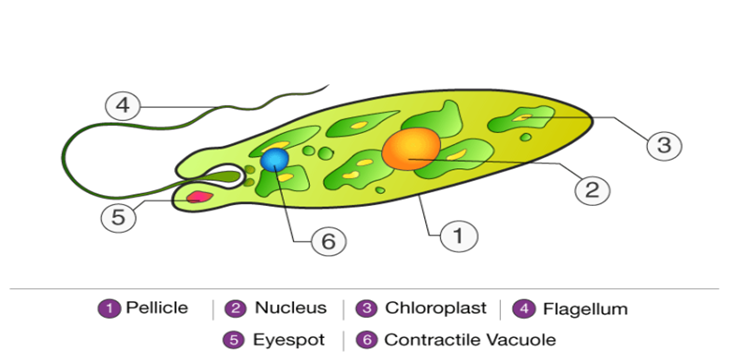
Nutrition in Human beings
Humans consist of the alimentary canal which starts from the mouth and ends at the anus. The parts of the alimentary canal are as follows-
- Mouth
- Pharynx
- Oesophagus/food pipe
- Stomach
- Small intestine
- Large intestine
- Rectum
- Anus
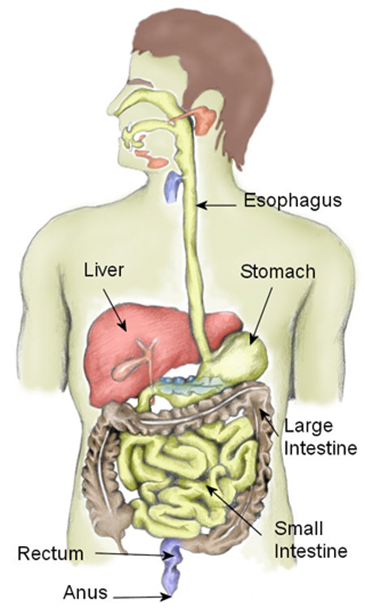
Human Digestive System
Mouth is the first portion of the alimentary canal. The mouth consists of a muscular tongue and teeth. The cavity inside the mouth is known as the oral cavity.
Mechanism of Digestion of Food
- Food digestion process begins in the mouth. Food is complex in nature.
- To break down food and absorb it, we need biological catalysts known as enzymes.
- The mouth contains salivary glands that secrete saliva. Saliva contains an important enzyme known as the salivary enzyme that breaks down starch into simple sugars.
- The food then passes via the oesophagus into the stomach. The movement of the food inside the oesophagus occurs via rhythmic contraction of muscles, this is known as peristalsis.
- The stomach contains gastric glands that secrete mucus, hydrochloric acid and pepsin. Pepsin is a protein-digesting enzyme.
- After the stomach, food then enters the small intestine. The small intestine is larger in herbivores due to cellulose digestion compared to carnivores.
- Complete digestion of carbohydrates, proteins and fats occurs in the small intestine.
- The small intestine receives secretions from the pancreas and bile from the liver. Bile helps in the emulsification of fats whereas the pancreas secretes enzymes such as trypsin for protein digestion. The intestinal wall also contains glands that secrete intestinal juice.
- The small intestine has villi that increase the surface area for the absorption of food.
- The unabsorbed food is then transferred to the large intestine where water is absorbed.
- Undigested food is then expelled out from the anus.
2. Respiration
notes added by teacher sudhanshu in section a
no need to add by Manas from section B
2. Respiration
- Books Name
- Iti Shree Science Book
- Publication
- Vaishnav Publication
- Course
- CBSE Class 10
- Subject
- Science
Respiration
Introduction
- Respiration broadly means the exchange of gases.
- Animals and plants have different means of exchange of gases.
- At a cellular level, respiration means the burning of the food for generating the energy needed for other life processes.
- Cellular respiration may take place in the presence or absence of oxygen.

Cellular Respiration
Cellular respiration is set of metabolic reactions occurring inside the cells to convert biochemical energy obtained from the food into a chemical compound called adenosine triphosphate (ATP).
- Metabolism refers to a set of chemical reactions carried out for maintaining the living state of the cells in an organism. These can be divided into two categories:These can be divided into two categories:
- Catabolism – the process of breaking molecules to obtain energy.
- Anabolism – the process of synthesizing all compounds required by the cells.
- Therefore, respiration is a catabolic process, which breaks large molecules into smaller ones, releasing energy to fuel cellular activities.
- Glycolysis, Krebs cycle and electron transport chain are the important processes of the cellular respiration.
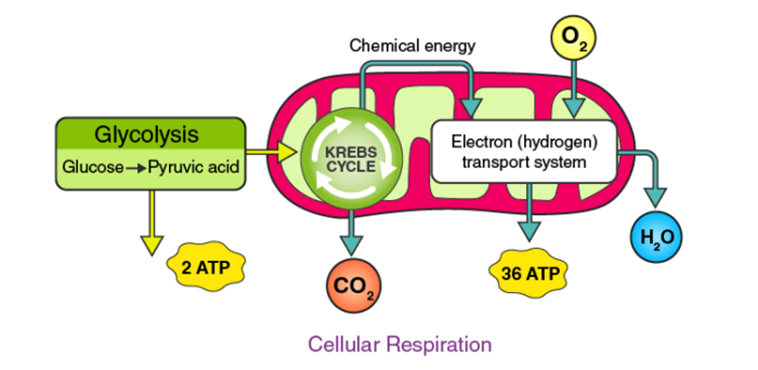
ATP
- It is the energy currency of the cell.
- ATP stands for Adenosine Triphosphate.
- This molecule is created as a result reactions like photosynthesis, respiration etc.
- The three phosphate bonds present in the molecule are high-energy bonds and when they are broken, a large amount of energy is released.
- Such released energy is then used for other metabolic reactions.
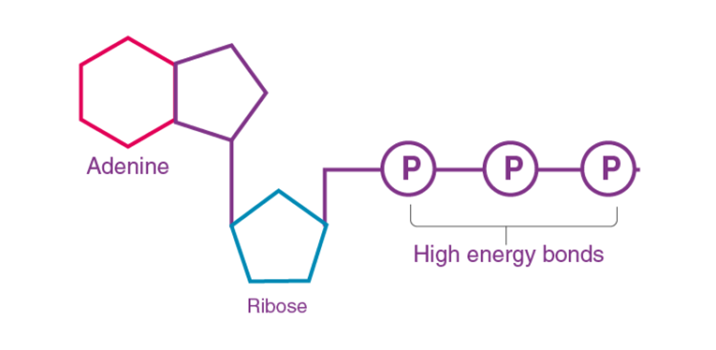
Types of Respiration
1. Aerobic respiration
Aerobic respiration is a process in which the food i.e. glucose is converted into energy in the presence of oxygen.
- The general equation of aerobic respiration as a whole is as given below-
Glucose + oxygen ⇒ Carbon dioxide + Water + Energy
- This type of respiration takes place in animals, plants and other living organisms.
2. Anaerobic respiration
- Respiration in muscles can be anaerobic when there is not enough oxygen.
- Glucose gets broken down into carbon dioxide and lactic acid.
- This results in the accumulation of lactic acid that makes the muscles sore.
- This type of anaerobic respiration is also known as lactic acid fermentation.
Respiration in Humans
- The human respiratory system is more complex and involves breathing, exchange of gases and cellular respiration.
- A well-defined respiratory system helps breathing and exchange of gases.
- Breathing involves the inhalation of oxygen and exhalation of carbon dioxide.
- The gaseous exchange takes place in the lungs and oxygen is supplied to all cells of the body.
- Cellular respiration takes place in each and every cell.
Human Respiratory system
- The human respiratory system involves the nose, nasal cavities, pharynx, larynx, trachea/windpipe, bronchi, bronchioles and alveoli.
- Bronchioles and alveoli are enclosed in a pair of lungs.
- The rib cage, muscles associated with the rib cage and diaphragm, all help in inhalation and exhalation of gases.
- Exchange of gases takes place between an alveolar surface and surrounding blood vessels.
- Alveoli provide a large surface area for exchange of gases.
Physiology of Respiration
- Breathing in humans is facilitated by the action of internal intercostal and external intercostal muscles attached to the ribs and the diaphragm.
- When the dome-shaped diaphragm contracts and becomes flattened and the rib cage is expanded due to the action of intercostal muscles, the volume of the lungs increases, pressure there drops down and the air from outside gushes in. This is inhalation.
- To exhale, the diaphragm relaxes, becomes dome-shaped again, chest cavity contracts due to the action of intercostal muscles, the volume inside the lungs decreases, pressure increases and the air is forced out of the lungs.
- Inhaled air increases the concentration of oxygen in the alveoli, so oxygen simply diffuses into the surrounding blood vessels.
- Blood coming from cells has more concentration of carbon dioxide than outside air and thus carbon dioxide simply diffuses out of the blood vessels into the alveoli.
- Thus, breathing takes place due to the combined action of intercostal muscles and diaphragm while the exchange of gases takes place due to simple diffusion.
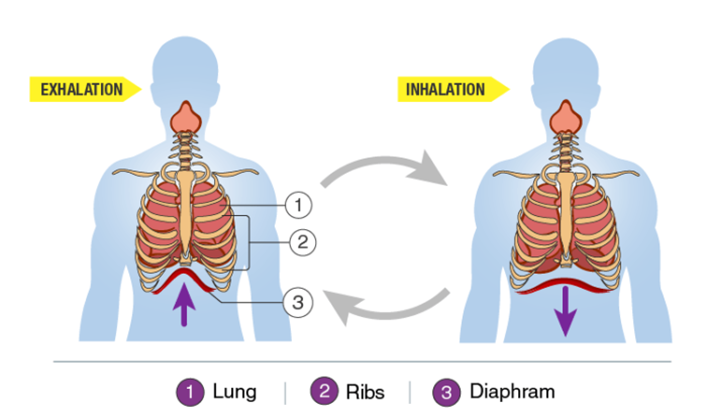
Inhalation and Exhalation
- The process of taking in air rich in oxygen is called inhalation.
- Similarly, the process of giving out air rich in carbon dioxide is called exhalation.
- One breath comprises one inhalation and one exhalation.
- A person breathes several times in a day.
- The number of times a person breathes in one minute is termed as his/her breathing rate.
3. Transportation
- Books Name
- Iti Shree Science Book
- Publication
- Vaishnav Publication
- Course
- CBSE Class 10
- Subject
- Science
Transportation in Human beings
Transportation
- All living organisms need a few necessary components like air, water, and food for their survival.
- On a regular basis, animals ensure these elements by breathing, drinking and eating.
- The required elements are transported to their body cells and tissues by a transportation system.
- In plants, the vascular tissue is responsible for transporting the substances.
Transportation in humans
- Transportation in humans is done by the circulatory system.
- The circulatory system in humans mainly consists of blood, blood vessels and the heart.
- It is responsible for the supply of oxygen, and nutrients, and the removal of carbon dioxide and other excretory products.
- It also helps to fight infections.
Human Heart
- The muscular organ which is located near the chest slightly towards the left in the thoracic region.
- The heart is the main pumping organ of the body.
- The human heart is divided into four chambers which are involved in the transportation of oxygenated and deoxygenated blood.
- The upper two chambers are called atria whereas the lower two chambers are called as ventricles.
Blood vessels
- Blood vessels carry blood throughout the body.
- There three types of blood vessels; arteries, veins and blood capillaries.
- Arteries carry oxygenated blood and veins carry deoxygenated blood.
- Gaseous exchange takes place between blood and cells at capillaries.
Difference between Arteries and Veins

Blood Pressure
The pressure exerted by the blood when it flows through the blood vessels is called blood pressure.
- There are two different variants of blood pressure; systolic and diastolic blood pressure.
- The pressure exerted on the walls of arteries when the heart is filling with blood is called diastolic pressure. It constitutes the minimum pressure on arteries.
- The normal range of diastolic blood pressure should be 60 – 80 mm Hg.
- The pressure exerted on the walls of arteries when the heart is pumping the blood is called systolic pressure. It constitutes the maximum pressure applied to the arteries.
- The normal range of systolic blood pressure should be 90 – 120 mm Hg.
Transportation in Plants
- Transportation is a vital process in plants.
- The process involves the transportation of water and necessary nutrients to all parts of the plant for its survival.
- Food and water transportation takes place separately in plants.
- Xylem transports water and phloem transports food.
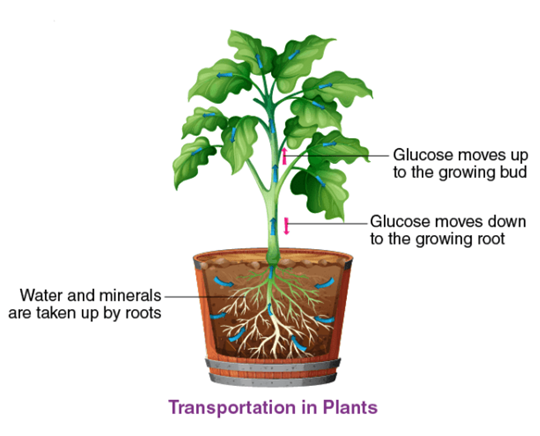
Phloem
- The phloem is responsible for translocation of nutrients and sugar like carbohydrates, produced by the leaves to areas of the plant that are metabolically active.
- Sieve tubes, companion cells, phloem fibres, and phloem parenchyma cells are the components of this tissue
- The flow of material through phloem is bidirectional.
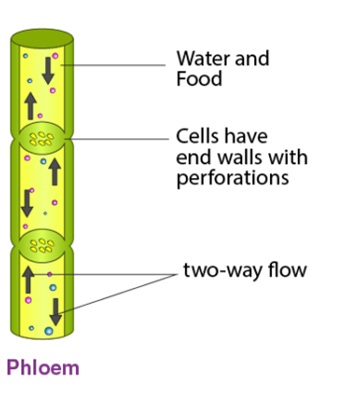
Transport of food in the plant
- Transport of food in the plant through phloem via a process such as mass flow is called as translocation.
- Photosynthates i.e. sugars and organic molecules such as amino acids, organic acids, proteins and inorganic solutes like potassium, magnesium, nitrate, calcium, sulfur and iron from source tissues (mature leaves) to the sink cells (areas of growth and storage) are transported through the phloem.
- Material like sucrose is loaded from leaves to phloem using the energy of ATP.
- Such a transfer increases the osmotic pressure causing the movement of water from nearby cells into phloem tissue and the material gets transported through the phloem.
- The same pressure is also responsible for the transfer of substances from phloem to tissues where food is required.
- Thus the bulk flow of material through phloem takes place in response to an osmotically generated pressure difference.
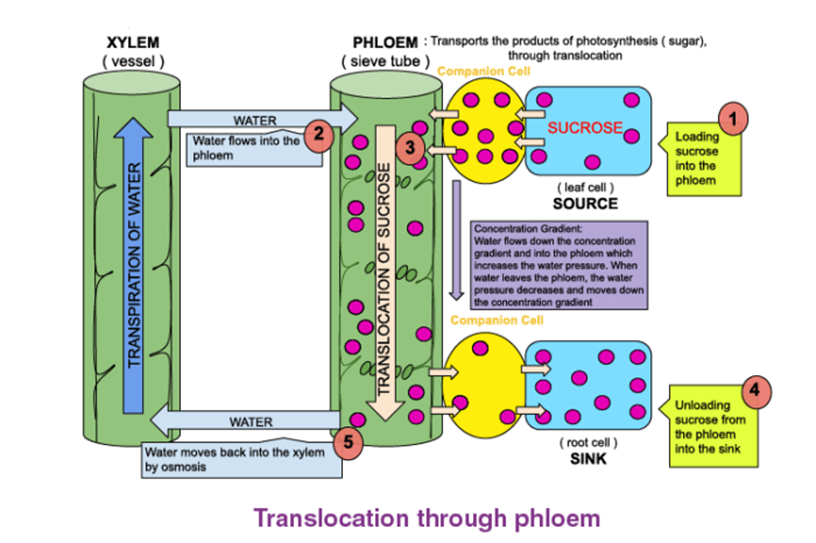
Xylem
- Xylem tissue transports water in plants from root to all other parts of the plant.
- Xylem tissue is made up tracheids, vessels, xylem fibres and xylem parenchyma.
The flow of water and minerals through xylem is always unidirectional.
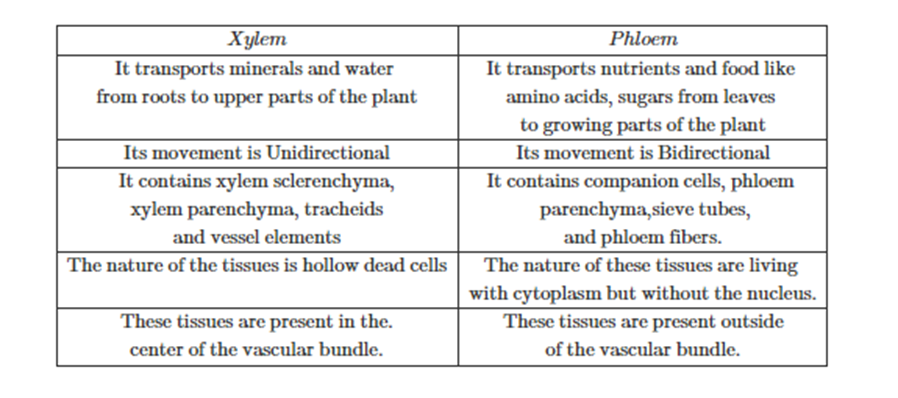
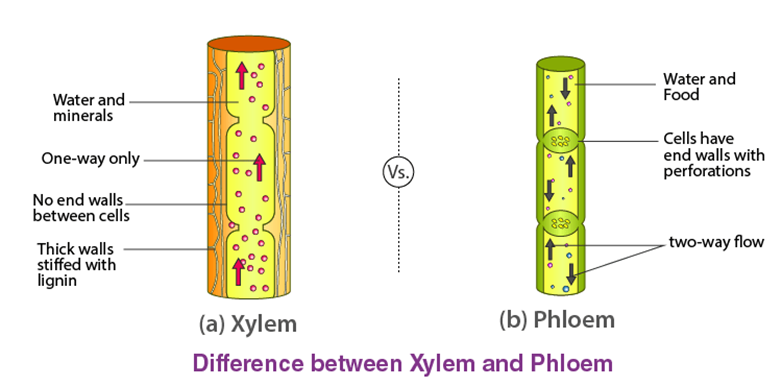
Root pressure
- Conduction of water through the xylem, from roots to upper parts of plants, is due to many forces acting together.
- One of the forces responsible for this is root pressure.
- Root pressure is osmotic pressure within the cells of a root system that causes sap to rise through a plant stem to the leaves.
- Root pressure helps in the initial transport of water up the roots.
Transport of water
Water is absorbed by the roots and is transported by xylem to the upper parts of the plant.
Imbibition, osmosis, root pressure and transpiration are the forces that contribute towards the upward movement of water, even in the tallest plants.
- Imbibition is a process in which water is absorbed by the solids. E.g. seeds take up water when soaked.
- Osmosis is a process where water moves from the area of its lower concentration to the area of its higher concentration.
- At the roots, the cells take up ions by an active process and this results in the difference of concentration of these ions.
- It leads to movement of water, in the root cells, by osmosis.
- This creates a continuous column of water that gets pushed upwards. This is root pressure.
- Transpiration contributes to the upward movement of water by creating a staw effect.
- It pulls the water column upwards as there is a continuous loss of water from leaves.
- All these forces act together for water transport through the xylem.
4. Excretion
- Books Name
- Iti Shree Science Book
- Publication
- Vaishnav Publication
- Course
- CBSE Class 10
- Subject
- Science
Excretion in Humans
Excretion is the process of removal of metabolic waste material and other non-useful substances.
- Organisms like animals have an advanced and specialized system for excretion.
- But plants lack a well-developed excretory system like that in animals.
- They do not have special organs for excretion and thus excretion in plants is not so complex.
Excretion in Unicellular organism
- In unicellular organisms such as amoeba and bacteria, the waste product is removed by simple diffusion through the general body surface.
- Unicellular organisms like the amoeba, and paramecium excrete excess through tiny organelles called contractile vacuoles.
- Undigested food in unicellular animals is excreted when the food vacuole merges with the general body surface and opens to the outside.
Excretory system in humans
- The excretory system in humans includes
- a pair of kidneys,
- a pair of ureters,
- a urinary bladder and
- urethra.
- It produces urine as a waste product.
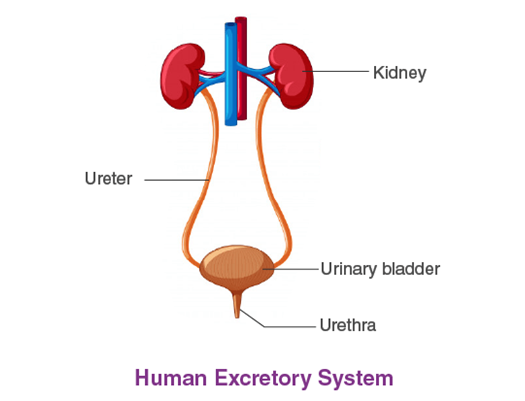
Kidney
- Paired kidneys are the main excretory organs of the body.
- They are basically the filtration units of the human body.
- Each kidney is made up of many tiny filtration units called nephrons.
- Kidneys perform crucial functions like:
- Filtering waste materials, medications, and toxic substances from the blood.
- Regulation of osmolarity i.e., fluid balance of the body.
- Regulation of ion concentration in the body.
- Regulation of pH.
- Regulation of extracellular fluid volume.
- Secreting hormones that help produce red blood cells, promote bone health, and regulate blood pressure.
Nephrons
Nephrons are the structural and functional unit of kidney.
- Each kidney has millions of nephrons and it forms the basic structural and functional unit of the kidney.
- Each nephron has two parts: Malpighian body and renal tubule.
- Malpighian body is made up of cup-like structure called Bowman’s capsule which encloses a bunch of capillaries called glomerulus.
- They together filter waste materials along with many useful substances.
- Renal tubule has regions called proximal convoluted tubule, Loop of Henle and distal convoluted tubule.
- These regions absorb back useful substances into the blood and also filter remaining waste substances.
- The output from nephrons is called urine.
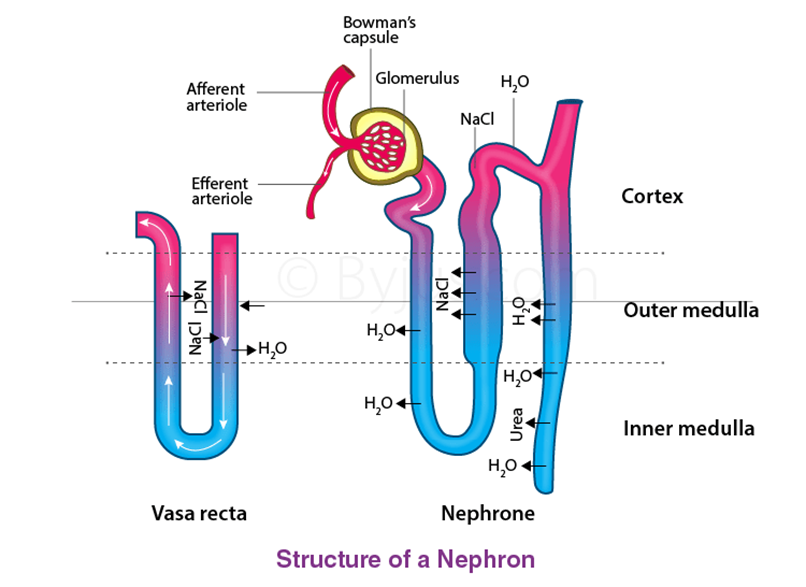
Haemodialysis
When the kidneys fail, it results in a lot of complications and to compensate this situation a technology called dialysis has been developed.
It uses a machine filter called a dialyzer or artificial kidney.
This is to remove excess water and salt, to balance other electrolytes in the body and remove waste products of metabolism.
Blood from the body is removed and flowed through a series of tubes made up of a semipermeable membrane.
A dialysate flows on the other side of the membrane, which draws impurities through the membrane.
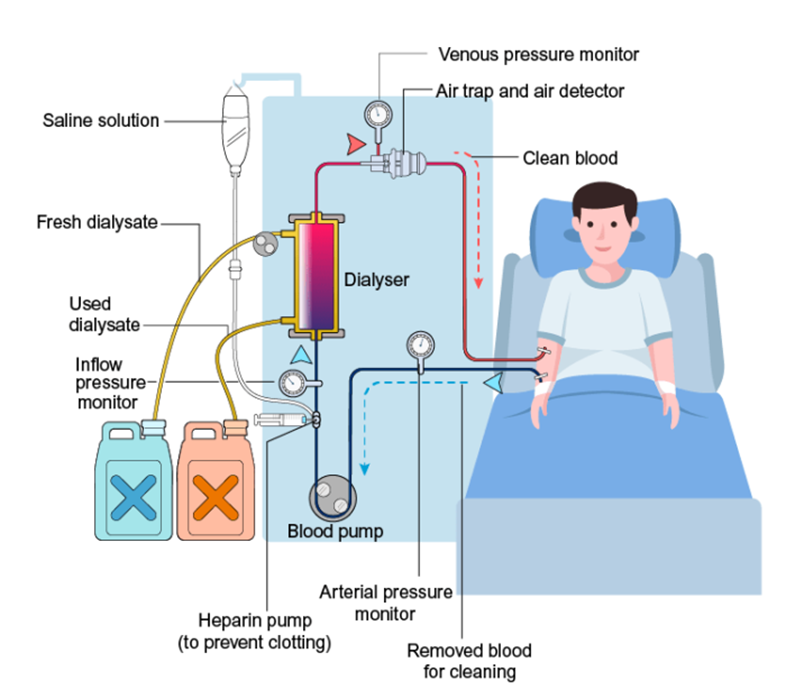
Excretion in plants
- The cellular respiration, photosynthesis, and other metabolic reactions produce a lot of excretory products in plants.
- Carbon dioxide, excess water produced during respiration and nitrogenous compounds produced during protein metabolism are the major excretory products in plants.
- Plants produce two gaseous waste products i.e., oxygen during photosynthesis and carbon dioxide during respiration.
- Excretion of gaseous waste in plants takes place through stomatal pores on leaves.
- Oxygen released during photosynthesis is used for respiration while carbon dioxide released during respiration is used for photosynthesis.
- Excess water is excreted by transpiration.
- Organic by-products generated by the plant are stored in different forms in different parts.
- The gums, oils, latex, resins, etc. are some waste products stored in plant parts like barks, stems, leaves, etc.
- Eventually, plants shed off these parts.
- Few examples of the excretory products of plants are oil produced from orange, eucalyptus, jasmine, latex from the rubber tree, papaya tree, and gums from acacia.
- Sometimes plants even excrete into the soil.

 Carrier Point
Carrier Point
